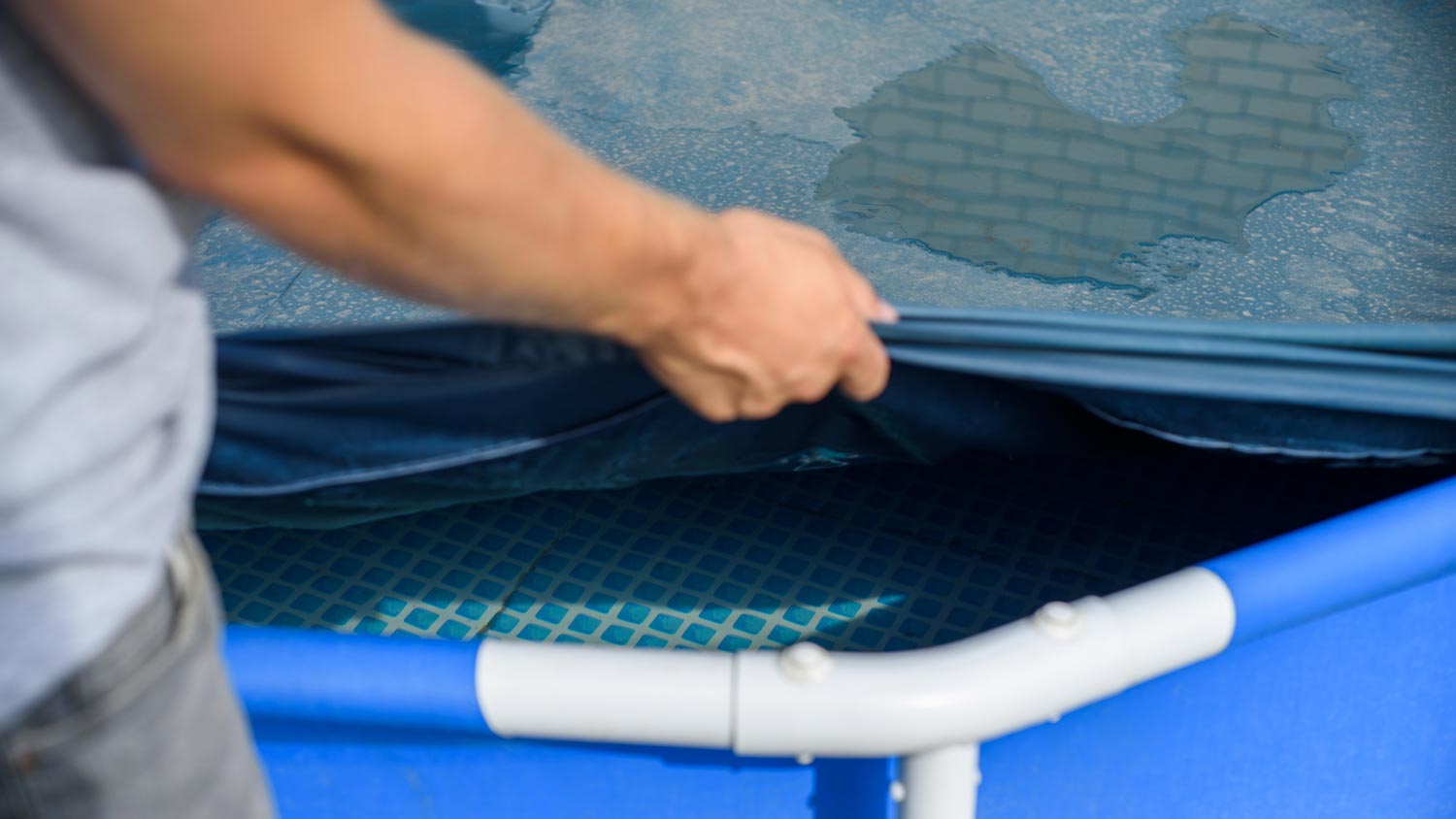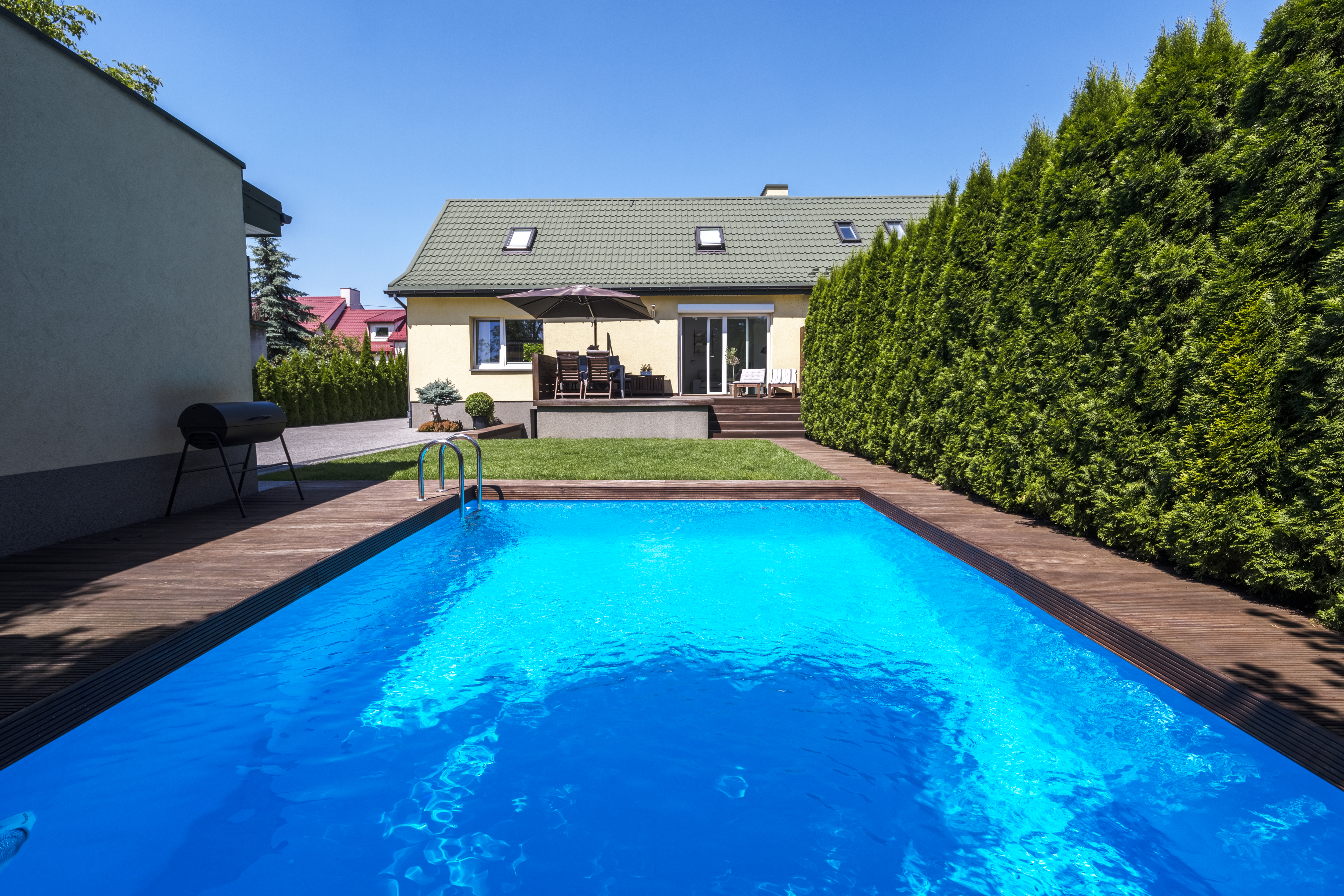
Pool remodels give your pool and yard a fresh new look. Find out average pool remodel costs in Charlotte so you can plan your project.
The average pool cover costs $1,822, but prices can range from an average of $869 to $2,826, depending on factors like type, size, and shape.


While winter pool covers start as low as $75, automatic pool covers can reach $25,000 or more.
The type of pool cover, track system, and pool shape and size are determining cost factors.
Labor costs for installing a manual pool cover ($400 to $1,500) are less costly than those for an automatic pool cover ($2,000 to $10,000).
Pool covers can cost anywhere from $149 to $4,600 or more, depending on the type of cover, as well as the cover's shape and size. For instance, a basic solar pool cover, which will help keep debris out of your pool and warm the water naturally, typically costs $30 to $150, whereas an automatic pool cover that opens and retracts with the push of a button costs an average of $15,000.
Whether your pine tree is constantly dropping needles or you want to winterize your pool for the season, a cover is a smart investment.
However, several factors affect the cost of a new pool cover. The type of cover you choose is the biggest cost factor, but your pool's type, size, and shape will also affect costs.
There are many different types of pool covers to choose from, ranging from basic solar covers and winter covers to glass covers and even automatic pool covers. But how much are pool covers, and what affects the cost?
The type you choose is one of the most significant cost factors. For instance, winter pool covers often only cost $75 to $250, while automatic pool covers can cost upward of $20,000.
| Pool Cover Type | Cost Range |
|---|---|
| Automatic | $7,000 – $25,000 |
| Custom | $1,500 – $6,000 |
| Manual | $500 – $5,000 |
| Net | $1,200 – $3,000 |
| Safety (mesh) | $1,200 – $3,000 |
| Safety (solid) | $1,800 – $3,600 |
| Solar | $30 – $150 |
| Walkable | $600 – $2,280 |
| Winter | $75 – $250 |
If you have a pool in a standard shape, such as an oval, square, or circle, you'll likely pay less for a pool cover than you would if your pool features a unique shape. That's because irregularly shaped pools require pool companies to cut a custom shape, whereas many companies will already have standard covers in stock for rectangular and circular pools. Customized covers will always cost more than standard ones for a given size and cover type.
Many local governments require a fence or barrier around a pool or hot tub for safety reasons. Check with your contractor beforehand about local regulations.
Generally speaking, large pools cost more to cover than small pools, in part because large pools require more cover material. But they also usually take longer to install and need more anchor points, which drive up labor costs if you hire a local pool company to install it for you. On average, you can expect to spend around $4 per square foot for your pool cover.
Your cover cost will vary considerably based on the type of cover, but the table below includes some average prices for common pool cover sizes.
| Pool Size | Average Cover Cost |
|---|---|
| 6-by-8 ft. | $190 |
| 8-by-12 ft. | $380 |
| 8-by-20 ft. | $640 |
| 10-by-8 ft. | $320 |
| 12-by-20 ft. | $960 |
| 16-by-32 ft. | $2,050 |
| 18-by-36 ft. | $2,590 |
| 20-by-40 ft. | $3,200 |
You can expect to pay slightly more to cover an in-ground pool than an above-ground pool since in-ground covers typically require extra features and equipment for proper installation, like ground anchors set into your deck, patio, lawn, or pool coping.
Above-ground pool covers usually range from $35 to $1,000, while in-ground pool covers cost between $75 and $10,000 in most cases, depending on the type, size, and features.
| Type of Pool | Average Cover Cost |
|---|---|
| Above-ground | $35 – $1,000 |
| In-ground | $75 – $10,000 |
Some pool covers you can easily install yourself, like standard solar covers, which don't typically require the installation of permanent systems. However, pool covers with lots of moving parts or permanent anchors, such as automatic pool covers or safety pool covers, usually require a pro to install track systems.
If you opt for a pool cover that requires professional installation, you should factor labor costs into your budget. Labor for manual pool covers usually ranges from $400 to $1,500, while installing an automatic cover can cost anywhere from $2,000 to $10,000 in labor, depending on your pool's size, shape, and features.
Manual and automatic pool covers work using a track system. There are three main types of tracks:
Top systems: Top-track systems are usually the most affordable, but they're highly visible, and since they sit above the surface of your pool, deck, and patio, they can pose a trip hazard.
Recessed systems: Recessed track systems cost significantly more than top-track systems because they require more advanced technology and more labor to recess them under your patio or deck. However, they still cost less than undertrack systems. They're not as visible as top-track systems, but because they're installed into the pool deck, they're easiest to install during the same time you install the patio around your pool. Retroactive installations will push the costs higher because of the added labor required to pull up the patio and replace it after the installation.
Undertrack systems: Undertrack systems usually cost the most, but they're also virtually invisible when not in use, so they won't cramp your pool's style.
If you have a basic pool cover, like a winter or solar cover, you can often repair tears and holes yourself with a patch kit, which shouldn't cost you more than $10 to $20. Since these don’t act as safety covers, a DIY repair is perfectly fine.
However, manual and automatic pool covers have lots of moving parts and electrical components, so you'll likely need to hire a pro to make repairs at some point in the cover's life span.
The cost of pool repairs typically ranges from $50 to $100 per hour. Your total can range from around $100 for minor repairs to $1,000 or more for major repairs on a high-end pool cover. Contact a local pool cover repair company for a quote.

Most homeowners can save money on labor costs by installing simple pool covers that don’t have a track system—such as winter and solar covers—themselves. These covers typically only need to be laid across the pool and tied or weighed down. Some solar covers include a rolling mechanism that makes using the cover easier, but these usually sit above the ground, so you can assemble them yourself with relative ease.
On average, you can save between $50 and $200 by installing these covers yourself. The savings are minimal because most of the cost of simple covers goes toward materials rather than labor.
If you’re installing a pool cover with a track system or a safety cover, we recommend you defer to a local in-ground pool company. Track systems can get extremely complicated to install properly, and any mistakes you make when installing a safety cover yourself could compromise its effectiveness.
Pool covers can quickly get expensive, sometimes reaching up to $4,600 on the high end. Luckily, there are some things you can do to save money on your pool cover costs.
Be realistic about your needs. Some pool covers, like automatic track covers, can cost $20,000 or more, while a standard winter cover of the same size might only be a few hundred dollars. Households with young children and curious pets or homeowners who entertain a lot may require higher-end covers to keep everyone safe. But if you don’t need the added safety and can do without the convenience of a track system, choosing a more basic design is the best way to save.
Avoid custom shapes. Custom pool covers cost more to fabricate to your specifications. If you have a custom-shaped pool, you could save some money by installing a larger, mass-produced rectangular cover over it. You’ll lose some yard space, and it won’t look as high-end, but you could save hundreds or even thousands of dollars in some cases.
Home is the most important place on earth, which is why Angi has helped more than 150 million homeowners transform their houses into homes they adore. To help homeowners with their next project, Angi provides readers with the most accurate cost data and upholds strict editorial standards. We survey real Angi customers about their project costs to develop the pricing data you see, so you can make the best decisions for you and your home. We pair this data with research from reputable sources, including the U.S. Bureau of Labor Statistics, academic journals, market studies, and interviews with industry experts—all to ensure our prices reflect real-world projects.
Want to help us improve our cost data? Send us a recent project quote to [email protected]. Quotes and personal information will not be shared publicly.
From average costs to expert advice, get all the answers you need to get your job done.

Pool remodels give your pool and yard a fresh new look. Find out average pool remodel costs in Charlotte so you can plan your project.

Is it time to refresh your pool? Before you get estimates, learn about pool liner replacement costs in Charlotte, North Carolina, to set an accurate budget.

Looking to get the most out of North Carolina summers? This guide will show how much installing an inground pool costs in Charlotte.

Ready to say goodbye to your swimming pool and hello to lush, green grass? Learn how to fill a swimming pool with dirt to ensure proper drainage for an even yard.

The key to maintaining an aboveground pool is using the right tools and chemicals for the job. Use this guide to learn how to clean an aboveground pool.

Swimming pool issues like algae or a clogged filter can happen to anyone. Learn more about common pool problems and how to fix them quickly and easily.